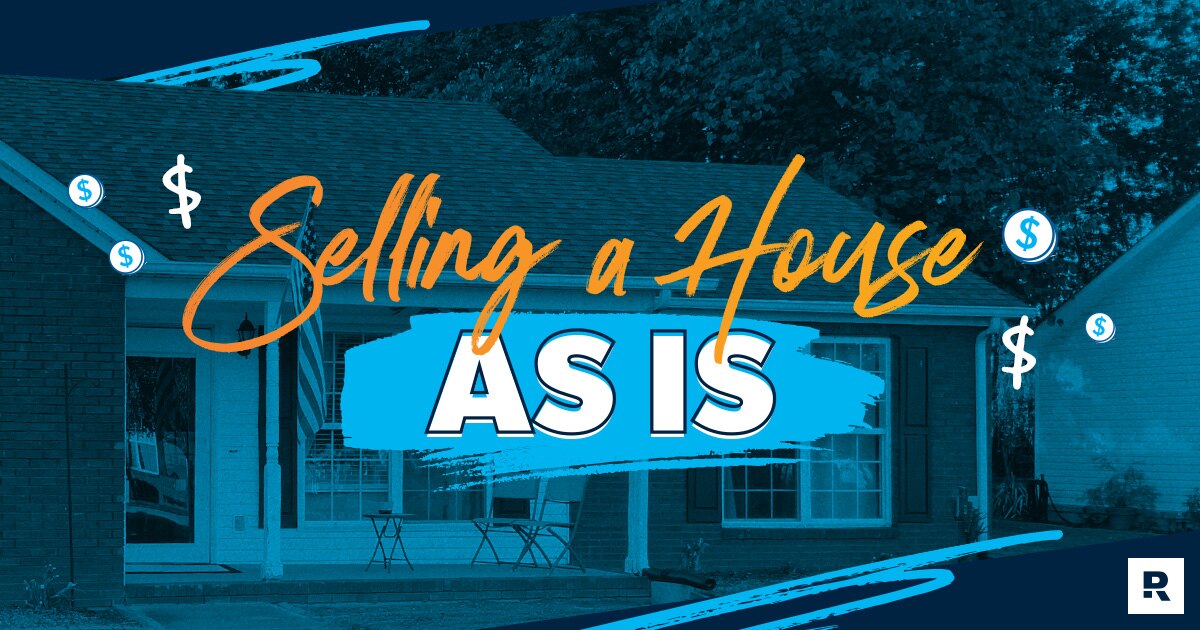
So, you’re thinking of selling your house, but it’s got problems—like a leaky roof, finicky plumbing, or maybe a 1970s kitchen with ugly orange cabinets.
Maybe you’re not sure it’s even worth the time and money it would take to fix up your home for buyers. And if you’re really honest, maybe you don’t want to fix it up. You’d rather just be done.
We get it. And there’s a potential solution: You can sell your house as is.
To help you decide whether to sell your house as is, we’ll answer some common questions—like what “as is” actually means and what the pros and cons are. Then we’ll get into how to sell your home as is.
Let’s jump in!
What Does It Mean to Sell My House As Is?
In real estate, selling a house as is means you won’t repair or improve the property before you sell it, and you won’t cover any repair costs for the buyer either. It tells buyers, “What you see is what you get.”
Find expert agents to help you sell your home.
Since the home won’t be repaired or improved before it’s sold, it’s priced and marketed to sell quickly. That means you don’t have to pour any extra money into it—and buyers can score a lower price and close quickly.
Should I Sell My House As Is?
There’s no hard and fast answer to this question—it all depends on your individual situation.
To help you get a good idea of what might influence your decision, here are the most common reasons people decide to sell their house as is.
Common Reasons to Sell a House As Is
- Money: Some folks trying to sell a fixer-upper simply don’t have the cash on hand to pay for the repairs. Others don’t think the cost of making a bunch of repairs will add enough value to the home to make it profitable.
- Timeline: Maybe you’re about to move and don’t have time to wait for renovations and repairs. Or you could be wanting to take advantage of a hot local real estate market before it cools off.
- Convenience: Making repairs sounds nice in theory, but it takes lots of time and effort—even if you’re paying someone else to do the work. Selling as is eliminates that hassle.
If one of those scenarios applies to you, selling your house as is could be the best option. If not, you may want to either complete the repairs before selling or offer to pay for the buyer to take care of them.
Either way, make sure you talk to your real estate agent before making your final decision.
Your Guide to Selling Your Home for Top Dollar
Learn our simple, step-by-step process that’ll steer you toward a quick and successful home sale and smart selling decisions.
Pros and Cons of Selling a House As Is
Pros
- You save time. You won’t have to wait for a contractor to finish repairs before you list your home. And because the price is lower, there’s a better chance the buyers will pay in cash. That means the closing process will likely move much faster since you’ll avoid the mortgage approval process, which always slows things down.
- You save money. Home renovations can get expensive. When you sell as is, you won’t have to spend a bunch of money—or worse, go into debt—to make major repairs or improvements, which can cost up to $150 per square foot.1 Imagine, just renovating a 100-square-foot kitchen might cost $15,000!
- You don’t have to negotiate on repairs. Going back and forth with a buyer over which repairs you will and won’t do is exhausting, especially if some of the repairs are nitpicky. And getting all those repairs done in a timely fashion is a headache. Selling as is eliminates that stress.
Cons
- You’ll probably get fewer offers. The lower price of an as-is home might attract buyers. But don’t be surprised if the repairs that need to be done scare some of them off. Plus, some lenders won’t even approve buyers for a mortgage on an as-is home. That might limit your potential buyers, and the people who are interested are more likely to be house flippers and real estate investors.
- You’ll make a smaller profit. When you’re selling a house as is, that typically means there’s a lot of work to be done—and the buyer knows they’ll have to eat the cost. Potential buyers will try like crazy to talk you down on price to make up for those repair costs, so don’t expect to turn a huge profit.
How to Sell a House As Is
To sell a house as is, you can pretty much follow the same steps as a standard home sale—you just won’t have to stage the home. But you will have to market it a little differently.
With an as-is home, you have to show everything—flaws and all. Sometimes that doesn’t matter and the buyer loves the place anyway. Other times, you’ll feel like your house is the kid who gets picked last in gym class.
Now here’s the good news: You can take some steps to help your home get picked sooner. To get a handle on how to market (and sell) your home as is, follow these tips:
1. Get Advice From a Local Real Estate Agent
You might not want to pay for an agent, but it’s always worth the cost to sell with a real estate agent—especially when you’re selling your home as is. For starters, they’ll help you set a realistic price. Sellers’ agents do a comparative market analysis (CMA) to find out what similar homes have sold for in your area. That way, you can set a fair price from the start and (hopefully) keep your home from sitting on the market too long.
They’ll also know how to find the best buyer. An agent has access to the Multiple Listing Service (MLS), a home-listing database that’s only operated by real estate professionals. They can use the MLS to hook you up with legit buyers who are actually interested in purchasing an as-is home.
And finally, your real estate agent can help you market your home’s positive features—like location, size and floor plan—so you can actually sell it for a reasonable price. And when you get an offer, your agent will step in to help you get a fair deal at the negotiating table.
2. Disclose Defects
When selling a house as, you have to tell potential buyers what they’re getting themselves into before making a deal. It’s the right thing to do, and in many cases, it’s the law.
Some states legally require you to give the buyer a report (called a seller’s disclosure) that shows buyers all the problems with your house ahead of time so they don’t try to back out of the deal later.
Here are a few examples of problems you might need to disclose to potential buyers:
- Foundation damage
- Plumbing problems
- Electrical issues
- Water intrusion
- Mold
Other states have a caveat emptor rule, which is just a fancy way of saying, “Let the buyer beware”—meaning it’s up to your buyer to learn the defects of your house.
Every state has different laws about disclosure reports, so check with your agent to find out what you’re legally obligated to disclose.
3. Do a Home Inspection Before Listing
So, how do you avoid getting slapped in the face by your state’s disclosure laws? Get a home inspection before you list your house. It usually only costs around $300–400, which is a small price to pay compared to losing a deal or getting sued for failing to disclose a serious defect.2
The inspector will tell you what’s wrong with your house—including some stuff you may not even know about—so you can put it in the disclosure. Plus, having a professional inspection done proves you have nothing to hide, which could help you sell your home faster.
And again, talk to your real estate agent. They can help you find an inspector, and they’ll be able to help you market your home’s best features, even if you have to disclose some stuff that isn’t so great.
4. Get Cost Estimates for Potential Repairs
Wait, I thought the whole point of an as-is home sale was to avoid paying for repairs! Yes, you’re correct. However, you still need to know the ins and outs of what’s wrong with your house and what it would cost to fix everything. If you get accurate cost estimates from local contractors, you’ll have more negotiating power if buyers try to lowball you on price.
Plus, you might find that some repair costs actually do fit in your budget. And if you make the repairs, you’ll have a better chance of earning more money at the closing table. So, make a list of what work needs to be done and get busy gathering cost estimates for each one.
Here are some average costs of common home remodeling projects:
|
Project |
Job Cost |
|
HVAC Replacement |
$7,0003 |
|
New Roof |
$9,5004 |
|
Basement Remodel |
$21,6005 |
|
Bathroom |
$12,1006 |
|
Kitchen |
$27,0007 |
5. Set a Realistic Price
Setting a price is about more than just knowing what your home needs—it’s also about knowing what your home already has going for it!
To make sure potential buyers aren’t just staring at a bunch of defects when they see your listing, you’ll want the help of an expert real estate agent. They’ll help you set an honest price for your home, based on both its good and bad features. That way you don’t have to worry about scaring off buyers or not earning your fair share of the deal.
How Much Do You Lose Selling a House As Is?
In 2024, the average cost of a fixer-upper home (which is often sold as is) was $283,000—while move-in ready homes sold for 29% more.8 That’s a bummer. But sometimes selling as is does make more sense mathematically than doing home improvements to boost value.
Here’s an example: Let’s say you’re wanting to sell a home that needs a new roof, an exterior paint job, carpet installation and repairs to the foundation. You learn that, as is, your home could sell for $300,000. But if you completed those repairs, the value would jump to $315,000.
So, you sit down and do the math on how much the repairs would cost:
Altogether the repairs come out to $19,700. That means they’d cost $4,700 more than they’d add to your home’s value. So if you paid for the repairs instead of selling the house as is, you’d actually lose money.
At the end of the day, the amount of money you’d lose—or save—by selling a house as is depends on your individual situation. That’s why it’s super important to do your research and work with an agent.
Next Steps
1. Calculate the cost of completing the repairs your home needs.
2. Crunch the numbers to see if you should make the repairs yourself or sell the house as is.
3. Connect with a RamseyTrusted® real estate agent.
Did you find this article helpful? Share it!

We Hear You!
We’re considering adding the ability to save articles to your Ramsey account.




